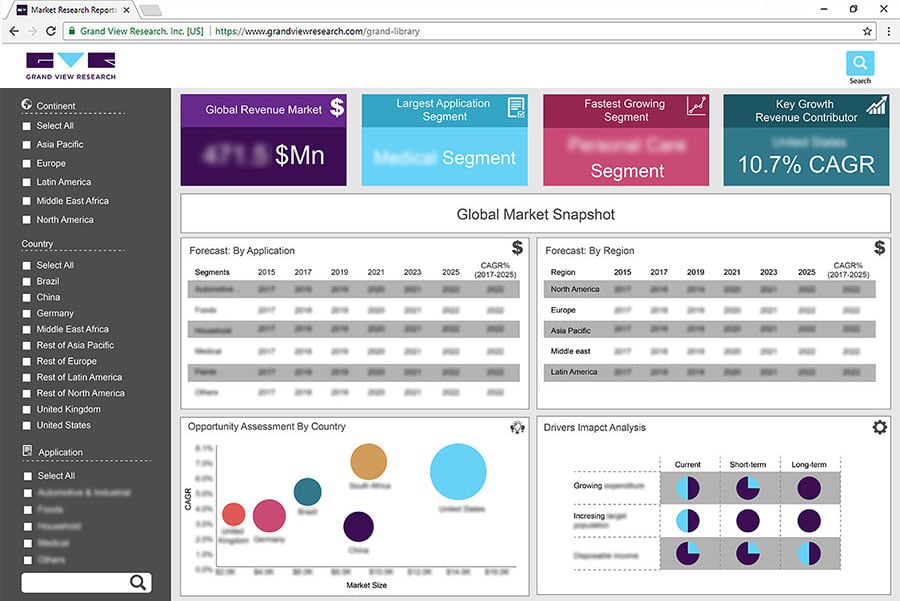- Home
- »
- Communication Services
- »
-
Telecom Services Market Size & Growth Analysis Report, 2030GVR Report cover
![Telecom Services Market Size, Share & Trends Report]()
Telecom Services Market Size, Share & Trends Analysis Report By Service Type (Mobile Data Services, Machine-To-Machine Services), By Transmission (Wireline, Wireless), By End-use, By Region, And Segment Forecasts, 2023 - 2030
- Report ID: GVR-4-68038-518-2
- Number of Report Pages: 215
- Format: PDF, Horizon Databook
- Historical Range: 2017 - 2021
- Forecast Period: 2023 - 2030
- Industry: Technology
Report Overview
The global telecom services market size was valued at USD 1,805.61 billion in 2022 and is expected to expand at a compound annual growth rate (CAGR) of 6.2% from 2023 to 2030. Rising spending on the deployment of 5G infrastructures due to the shift in customer inclination toward next-generation technologies and smartphone devices is one of the key factors driving this industry. An increasing number of mobile subscribers, soaring demand for high-speed data connectivity, and the growing demand for value-added managed services are the other potential factors fueling the market growth. The global communication network has undoubtedly been one of the prominent areas for continued technological advancements over the past few decades.
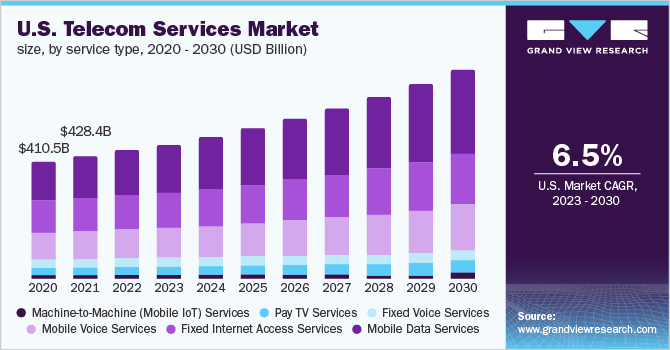
The industry’s product offering evolved in the late 19th century from only voice and visual signals in terms of facsimile or telegraphs over wired infrastructure to the current scenario of exchanging audio, video, and text content over numerous wireless infrastructures. The market for telecom services has also witnessed significant improvements in data speeds, from Global System for Mobile communications (GSM) and Code Division Multiple Access (CDMA) to Third Generation (3G), Fourth Generation (4G), and now the commercialization of Fifth Generation (5G) networks. The advent of data connectivity has made possible the reduction in the duration of transferring large chunks of data from days to hours and now to a few seconds.
In today’s digital age, customers favor Over-The-Top (OTT) channels for a variety of reasons, among which the number of viewing options, and the pricing offered are the most prominent ones. The OTT solution providers offer video, audio, and other media content over the internet. Usually, they are not bound to price agreements with limited viewing choices to pick from. Common instances of OTT applications are Netflix, Amazon Video, Roku, Hotstar, HBO, and others.
Consumers and marketers alike are getting more acquainted with OTT applications and content. Furthermore, smartphone display and sound quality, open-source platforms, and super-fast Internet Protocol (IP) networks among other innovative services act as mobilizing factors to draw more consumers to the OTT providers 'freemium-based' business models, thus witnessing an ever-growing adoption rate and boosting the market growth.
As people worldwide struggle with the realities of the COVID-19 pandemic, digital entertainment platforms as well as the global telecom service providers have benefitted from the current scenario due to their industry type and business model. In a current worldwide lockdown scenario, a shift among masses to remote working will fuel the demand for network connectivity and infrastructure. Similarly, the temporary shutdown of multiplexes and other outdoor entertainment avenues due to strict social distancing has shot up the usage of various digital platforms, including social media, gaming, and OTT applications. The mobile voice traffic has also witnessed an upsurge during this period with prominent communication operators reporting an enormous escalation in their voice traffic since the outbreak of the pandemic.
However, the escalating consumption of digital media platforms by global customers has resulted in the sudden demand for higher bandwidths with high-speed connectivity. With the upsurge in the consumption of these platforms, the telecom service companies are urging OTT providers to reduce the streaming resolution of their media content. In fact, the Cellular Operators Association of India (COAI) has requested video streaming providers to reduce their content quality from High Definition (HD) to Standard Definition (SD). To avoid the congestion in internet traffic, especially when most people are working from home and require high bandwidth, some governments are also helping the market for telecom services to ensure the smooth functioning of their data and voice carriers.
For instance, Ireland’s Commission for Communications Regulation (ComReg) has released an extra radio spectrum within the 700 MHz to 2.6 GHz bands to enable mobile network operators to cater to their customers accessing 3G as well as 4G technologies. Similarly, the Federal Communications Commission (FCC) has allocated an additional spectrum to the communication network service providers ensuring continuity of broadband in the U.S.
Moreover, several leading telecom operators such as AT&T Inc.; Verizon Communications Inc.; and NTT have shown declining revenue growth in 2020 owing to the slow demand for telecom services for corporate and business applications. Furthermore, the significant decline in the global economy has resultantly reduced the per capita income of consumers. This has led to the minimized spending on non-essential products and services. Thus, it has moderately affected the market growth in 2020.
Service Type Insights
In 2022, the mobile data services segment held a market share of over 37.0% in the global market. This is attributed to the significantly growing usage of smartphones among consumers. Rapidly rising demand for high-speed broadband services for corporate and residential applications is further expected to bolster the segment growth over the forecast period. Moreover, a massive demand for accessing online 4K UHD videos and playing online cloud gaming is estimated to spur the data services market growth.
The evolution of the Internet of things (IoT) devices has raised its proliferation across several industry verticals, including healthcare, manufacturing, energy and utilities, and the public sector, among others. The number of IoT-connected devices is expected to exceed 50 billion by 2030. The rapidly growing IoT devices would require high-speed data connectivity to operate and communicate seamlessly. Therefore, the demand for telecom services is expected to witness significant growth in the machine-to-machine services segment over the forecast period.
Transmission Insights
In 2022, the wireless segment accounted for a market share of more than 76.0% in the global market. The advent of cloud-computing technologies, artificial intelligence, and IoT is presumed to majorly contribute to the growth of wireless communication channels worldwide. Over the years, there has been a rapid deployment of systems for Wireless Local Area Networks (WLANs) that has enabled internet access to cellular devices in private homes, public spaces, airports, office buildings, cafeterias, and other areas. Such wireless densification to simplify work processes and automate routine test actions is presumed to prove beneficial, hence registering a robust CAGR in the forthcoming years.
Furthermore, a growing 5G wave would offer demarcation between wireless and wireline networks and is envisioned to converge the communication modes into a unified end-to-end system in public, residential, and enterprise spaces. In parallel to the wireless infrastructure of 5G, the wireline infrastructure also plays a vital role in offering better mobile user quality and optimizing network performance. In addition, wireline technologies enable data/voice traffic from the nodes to where content is streamed, hosted, and manipulated.
Wireline communication involves the transfer of information via twisted pair, coaxial, and optical fiber cables. The wireless method transmits information Over-The-Air (OTA) using transmitters, receivers, and Radio Frequency (RF) waves. The moderate growth of the wireline segment is attributed to a rising number of SMEs and MNCs in countries, including the U.K., the U.S., and China, that utilize an extensive network of Public Switched Telephone Network (PSTN) and Integrated Services Digital Network (ISDN).
End-use Insights
In 2022, the consumer/residential segment accounted for the largest revenue share of more than 59.0% and is projected to maintain its lead over the forecast period. The significant growth is ascribed to the proliferation of smartphones worldwide. There were more than 8 billion mobile subscribers recorded globally in 2020, wherein more than 60% of the population was using smartphones. The private telecom operators account for a larger subscriber base as compared to government-owned companies. In addition, the growing demand for OTT applications is contemplating the users to subscribe to wireless internet offerings, thereby significantly contributing to the deployment of communication networks at a broader level. Additionally, the growing trend of using ultra-high-definition videos and online gaming is expected to boost the segment growth over the forecast period.
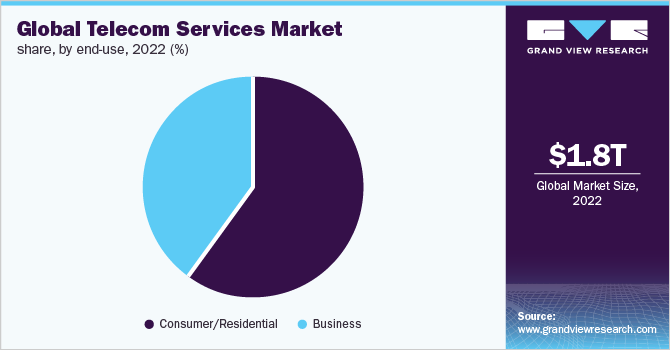
The demand for telecom services is increasing in business applications with the deployment of next-generation high-speed networks. Businesses are installing 5G small cell networks and private LTE and 5G networks to access faster data bandwidth in order to avoid latency in their network. The enhanced bandwidth connectivity would help businesses cater to their client's requirements with minimum waiting time and improve the overall customer experience. Moreover, the key business application areas include VoIP services, fixed and mobile data connectivity, unified communication, and other services. To handle a rapidly increasing chunk of customers’ datasets, it would require unified and fast network connectivity across businesses globally. This, in turn, is estimated to fuel the segment growth from 2023 to 2030.
Regional Insights
In 2022, the Asia Pacific captured more than 33.0% of share and is expected to grow at a CAGR of 7.0% from 2023 to 2030. The region is likely to attract more than half of the new mobile subscribers by 2030. The regional market is primarily driven by e-commerce and retailer buy-in platforms, smartphone ubiquity, and investments in 5G networks. China, Japan, and India have emerged as significant contributors to regional market growth. According to industry expert analysis, in February 2022, China recorded 1.02 billion internet users, which is more than three times the number of the third-placed United States, which had just over 307 million. India recorded the second highest internet users in February 2022.
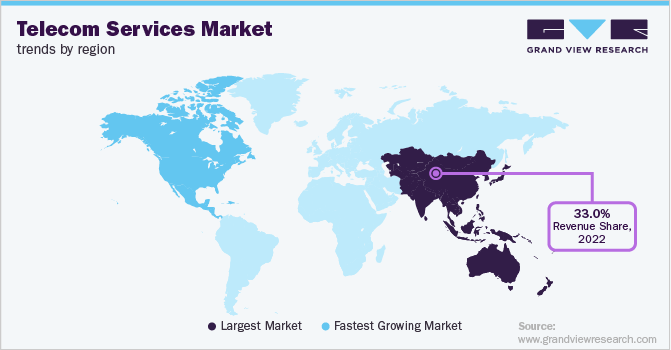
Furthermore, rising government initiatives on digital integration through Information Communication Technologies (ICT) are anticipated to fuel the APAC telecom services market growth. For instance, in 2021, the Indian government allocated over USD 27.33 billion on the development of 100 smart city projects, where IoT plays a significant role in those cities qualifying as ‘smart cities’.
Moreover, North America is expected to account for a considerable revenue share in 2021 to come on account of high consumer spending on mobile phones, coupled with the early adoption of digitized technologies. The current launch of 5G in South Korea, Australia, Germany, the U.K., and the U.S. is anticipated to drive the market. According to GVR analysis, more than 20% of communication connections worldwide is projected to incorporate 5G networks by 2030 with a strong presence in North America and Europe.
Key Companies & Market Share Insights
Key market players are strategically focused on mergers and acquisitions in order to expand their geographical presence and overall product portfolios. For instance, in April 2020, T-Mobile US, Inc. acquired Sprint Corporation, a U.S.-based telecommunication company. The strategic merger was aimed to build robust 5G network infrastructure in the U.S. and capture the maximum market in rural as well urban areas. The merger will make a proposed investment of nearly USD 40 billion into its business, network, and others over the next three years.
Moreover, key market players are investing a significant amount in acquiring the necessary spectrum for offering next-generation services. Having an adequate spectrum would allow the market players to strengthen their overall portfolios and expand their subscriber base across various countries. For instance, in Feb 2021, AT&T Inc. and Verizon Communications spent around USD 70 billion combinedly on the 5G spectrum to provide improved network connectivity to their customers. Additionally, several other telecom operators such as China Mobile Ltd., KT Corporation, BT Group plc (EE), and Vodafone Group plc are significantly investing to procure millimeter wave (mmWave) spectrum for delivering enhanced bandwidth connectivity for business and consumer applications. Some prominent players in the global telecom services market include:
-
AT&T Inc.
-
Verizon Communications Inc.
-
Nippon Telegraph and Telephone Corporation (NTT)
-
China Mobile Ltd.
-
Deutsche Telekom AG
-
SoftBank Group Corp.
-
China Telecom Corp Ltd.
-
Telefonica SA
-
Vodafone Group
-
KT Corporation
-
Bharati Airtel Limited
-
Reliance Jio Infocomm Limited
-
KDDI Corporation
-
Orange SA
-
BT Group plc
-
Comcast Corporation
Telecom Services Market Report Scope
Report Attribute
Details
Market size value in 2023
USD 1,885.41 billion
Revenue forecast in 2030
USD 2,874.76 billion
Growth Rate
CAGR of 6.2% from 2023 to 2030
Base year for estimation
2022
Historical period
2017 - 2021
Forecast period
2023 - 2030
Quantitative units
Revenue in USD billion and CAGR from 2023 to 2030
Report coverage
Revenue forecast, company ranking, competitive landscape, growth factors, and trends
Segments covered
Service type, transmission, end-use, region
Regional scope
North America; Europe; Asia Pacific; Latin America; MEA
Country scope
U.S.; Canada; U.K.; Germany; France; Italy; China; Japan; India; South Korea; Brazil; Mexico
Key companies profiled
AT&T Inc.; Verizon Communications Inc.; NTT; China Mobile Ltd.; Deutsche Telekom AG; SoftBank Group Corp.; China Telecom Corp Ltd.; Telefonica SA; Vodafone Group; KT Corporation; Bharati Airtel Limited; Reliance Jio Infocomm Limited; KDDI Corporation; Orange SA; BT Group plc; Comcast Corporation
Customization scope
Free report customization (equivalent up to 8 analysts working days) with purchase. Addition or alteration to country, regional & segment scope.
Pricing and purchase options
Avail customized purchase options to meet your exact research needs. Explore purchase options
Segments Covered in the ReportThis report forecasts revenue growth at the global, regional, and country levels and provides an analysis of the latest industry trends and opportunities in each of the sub-segments from 2017 to 2030. For the purpose of this study, Grand View Research has segmented the global telecom services market report based on service type, transmission, end-use, and region:
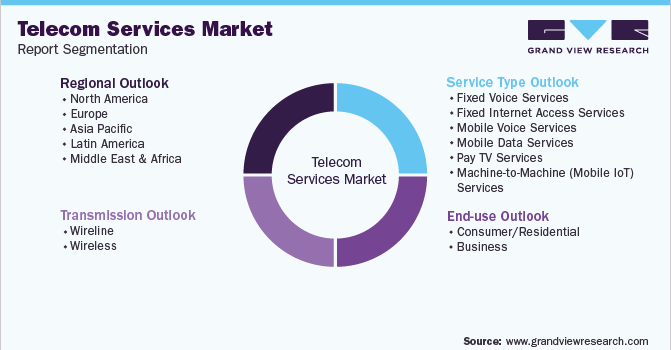
-
Service Type Outlook (Revenue, USD Billion, 2017 - 2030)
-
Fixed Voice Services
-
Fixed Internet Access Services
-
Mobile Voice Services
-
Mobile Data Services
-
Pay-TV Services
-
Machine-to-Machine (Mobile IoT) Services
-
-
Transmission Outlook (Revenue, USD Billion, 2017 - 2030)
-
Wireline
-
Wireless
-
-
End-use Outlook (Revenue, USD Billion, 2017 - 2030)
-
Consumer/Residential
-
Business
-
IT & Telecom
-
Manufacturing
-
Healthcare
-
Retail
-
Media & Entertainment
-
Government & Defense
-
Education
-
BFSI
-
Energy and utilities
-
Transportation & Logistics
-
Travel & Hospitality
-
O&G and Mining
-
Others
-
-
-
Regional Outlook (Revenue, USD Billion, 2017 - 2030)
-
North America
-
U.S.
-
Canada
-
-
Europe
-
U.K.
-
Germany
-
France
-
Italy
-
-
Asia Pacific
-
China
-
India
-
Japan
-
South Korea
-
-
Latin America
-
Brazil
-
Mexico
-
-
Middle East & Africa (MEA)
-
Frequently Asked Questions About This Report
b. The global telecom services market size was estimated at USD 1,805.61 billion in 2022 and is expected to reach USD 1,885.41 billion in 2023.
b. The global telecom services market is expected to grow at a compound annual growth rate of 6.2% from 2023 to 2030 to reach USD 2,874.76 billion by 2030.
b. In 2022, the mobile data services segment held the largest share of nearly 37.1% in the telecom services market, and is expected to exhibit a significant CAGR from 2023 to 2030. This is attributed to the significantly growing usage of smartphones among consumers.
b. The consumer/residential end-use segment accounted for the largest revenue share of more than 59.0% in the telecom services market in 2022, and is projected to maintain its lead over the forecast period. The significant growth is ascribed to the proliferation of smartphones worldwide.
b. Asia Pacific captured the largest share of more than 33.5% in the telecom services market in 2022, and is expected to witness significant growth from 2023 to 2030. The region is likely to attract more than half of the new mobile subscribers by 2030.
b. The wireless segment accounted for the largest share of over 76.0% in 2022 in the telecom services market, and is expected to exhibit a significant CAGR from 2023 to 2030.
Share this report with your colleague or friend.
![gvr icn]()
NEED A CUSTOM REPORT?
We can customize every report - free of charge - including purchasing stand-alone sections or country-level reports, as well as offer affordable discounts for start-ups & universities. Contact us now
![Certified Icon]()
We are GDPR and CCPA compliant! Your transaction & personal information is safe and secure. For more details, please read our privacy policy.
We are committed towards customer satisfaction, and quality service.
"The quality of research they have done for us has been excellent."





